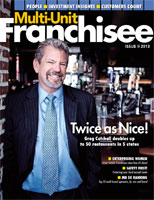There's a New Environment Dawning: Time to be Nimble as Markets Continue to Change
There's an old adage on Wall Street: When someone says, "It's different this time," run as far and as fast as you can.
After surveying today's overarching trends, however, an important tipping point seems close at hand; one that tees up an investing environment vastly different than the one we've known for decades. Survival and success will require different thought processes, strategies, and investment tactics than those we've relied on before.
When I started my investment career in the 1980s, the marginal income tax rates for top earners had fallen from 70 percent to 50 percent, and a mere 5 percent of the population owned equities. Bond yields stood in the upper teens/low 20s, and scores of wizened industry veterans declared they'd wait to invest until dividend yields exceeded bond yields. The Dow Jones Industrial Average had eclipsed 1,000 points--the first time it had traded there since the 1960s--yet the market's prices-to-earnings ratio stood at seven.
In the intervening decades, bond prices soared as yields dropped to zero (or below, if inflation is factored in). Companies cleaned up their balance sheets with lower-rate debt, benefited from the productivity enhancements brought by technological innovation, and experienced the delightful tailwinds of globalization and plummeting commodities costs.
Those were definitely fun times while they lasted. But change is in the air.
The new environment
- Bond bust. After sliding for 30 years, it's highly unlikely that bond yields can go much lower; the end of the bond bull may well be nigh. For the millions of bond fund investors late to the party, the notion that one can lose money in bond funds may become as harsh a reality as 2001-02 was to technology investors. Historically purchased for safety and yield, fixed income investments--particularly in the form of mutual funds--may well not offer either in the years to come.
- Fewer players. The new laws and regulations enacted in response to the market crashes of 2001-02 and 2008-09 put a significantly greater compliance and infrastructure burden on purveyors. That, in turn, has increased the cost to do business and made the barriers to entry even higher. Realistically, given an increasingly global and more regulated investment environment, a firm must be large enough to support global coverage of multiple asset classes, or be small but incredibly deep and focused on one area of expertise.
- Inflationary pressures. In the wake of all the money that central bankers have printed in recent years, inflation will most likely pick up in the not-too-distant future. I suspect few portfolio managers know how to invest during inflationary times--and even fewer corporate chieftains know how to operate amid such pressures.
- Global strength. Deleveraging among developed countries will prompt global companies to seek growth elsewhere. While investors fret over political gridlock, deficits, and deleveraging woes within developed countries, corporations based in those same countries can now do their business all around the world, and they are. Furthermore, they can keep their cash and their investments in countries that not only offer better development opportunities but also friendlier tax policies.
- The developing middle. Growth will come from burgeoning middle classes in developing countries. By one estimate, 3 billion additional people will move into the middle class globally over the next 20 years. That is good for consumer companies, commodities and infrastructure firms, industrial/infrastructure firms, and more.
- Overseas economy. The domestic unemployment rate may remain higher than before, yet the economy can still do okay. While part of the unemployment rate likely represents the unemployed whose skills no longer match today's jobs, this reality doesn't prevent companies from conducting business and expanding their operations overseas.
Potential investment implications
- Stock surge. Stocks will be in vogue as many (most?) institutional investors are woefully underinvested in them. Ever since the 2001-02 downturn, such investors have flocked to hedge funds and private equities. However, many have become frustrated by the inherently complicated structure, lack of liquidity and income, and opacity often associated with these investments. The fact that stocks returned more than 16 percent last year on average--and provide potentially daily liquidity and a better-than-bonds average yield--is making the pundits take notice.
- Cap values. Any big migration back into stocks would likely start with the large- and mega-cap stocks where liquidity and coverage are the best. When these investments become too expensive, it's likely that same trend would trickle down to small-cap stocks. (Indeed, the two asset classes that performed best in the inflationary 1970s were real assets and small-cap stocks).
- Global cap bias. Given more favorable fundamentals, sounder country-of-origin balance sheets, and the increasing liquidity of local markets, emerging and frontier market small-cap stocks may do better than U.S. small caps.
- Real assets, real strength. Real assets (timber, energy, precious metals, and other commodities) have historically held their value well during inflationary times. After all, at the end of the day, there's something real to hang on to. I suspect this time will be no different.
So there you have it. I'm going out on a limb and declaring the old era nearly gone and a new one dawning. Remember that change isn't necessarily bad; it just means things will be different. And for the nimble and open-minded, different can be fun!
 Carol M. Schleif, CFA, is regional chief investment officer at Abbot Downing, a Wells Fargo business that provides products and services through Wells Fargo Bank, N.A. and its affiliates and subsidiaries. She welcomes questions and comments at carol.schleif@abbotdowning.com.
Carol M. Schleif, CFA, is regional chief investment officer at Abbot Downing, a Wells Fargo business that provides products and services through Wells Fargo Bank, N.A. and its affiliates and subsidiaries. She welcomes questions and comments at carol.schleif@abbotdowning.com.
Share this Feature
Recommended Reading:
Comments:
comments powered by DisqusFRANCHISE TOPICS
- Multi-Unit Franchising
- Get Started in Franchising
- Growth
- Operations
- Open New Units
- Leadership
- Marketing
- Technology
- Legal
- Awards
- Rankings
- Trends
- Featured Franchise Stories
FEATURED IN

Multi-Unit Franchisee Magazine: Issue 2, 2013
$564,300
$286,852




 The multi-unit franchise opportunities listed above are not related to or endorsed by Multi-Unit Franchisee or Franchise Update Media Group. We are not engaged in, supporting, or endorsing any specific franchise, business opportunity, company or individual. No statement in this site is to be construed as a recommendation. We encourage prospective franchise buyers to perform extensive due diligence when considering a franchise opportunity.
The multi-unit franchise opportunities listed above are not related to or endorsed by Multi-Unit Franchisee or Franchise Update Media Group. We are not engaged in, supporting, or endorsing any specific franchise, business opportunity, company or individual. No statement in this site is to be construed as a recommendation. We encourage prospective franchise buyers to perform extensive due diligence when considering a franchise opportunity.